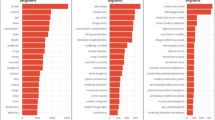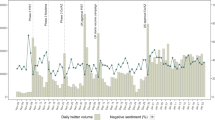Abstract
As more people use social media as a source of news and information, it is important to understand its impact on individual health decisions. This article compares the sentiment expressed in COVID-19 related tweets with national rates for first dose vaccinations as recorded by the Centers for Disease Control and Prevention. To conduct the study, the text from over 570,000 COVID-related tweets from January 2021 to December 2021 was captured. The tweets were segregated by month and Google Cloud’s Natural Language API was used determine the sentiment in each tweet, with each post labeled as having positive, negative, or neutral sentiment. Overall, there was greater prevalence of negative sentiment as compared with positive sentiment during the period of review, with 45% of tweets negative, 33% positive and 22% neutral. The number of positive and negative tweets was more balanced in the early months of 2021 (when the vaccine was first available) and became decidedly more negative in the later part of the year, as misinformation about the vaccines spread prolifically on social media. This comparison of the tweet sentiment to first-time vaccine doses in the US shows that misinformation about vaccines on social media appears to have had an impact on behavior. Vaccine adoption declined significantly in the latter half of 2021, even as vaccines and information from public health officials regarding their efficacy became more available to the general public. These findings are validated by subsequent analysis of word usage by month, with positive comments about vaccines and vaccination in January through May coinciding with high vaccination rates, and a negative conversational shift to variants, increased deaths and suspicion about vaccine safety and effectiveness later in the year during a stagnation period in vaccinations.
Access this chapter
Tax calculation will be finalised at checkout
Purchases are for personal use only
Similar content being viewed by others
References
The Washington Post: Twitter sees record number of uses during pandemic, but advertising sales slow (2020). https://www.washingtonpost.com/business/economy/twitter-sees-record-number-of-users-during-pandemic-but-advertising-sales-slow/2020/04/30/747ef0fe-8ad8-11ea-9dfd-990f9dcc71fc_story.html. Accessed May 2022
Statista: Number of monetizable daily active Twitter users (mDAU) worldwide from 1st quarter 2017 to 1st quarter 2022 (2022). https://www.statista.com/statistics/970920/monetizable-daily-active-twitter-users-worldwide/. Accessed May 2022
Tweet Binder: How many tweets about Covid-19 and Coronavirus? (2020). https://www.tweetbinder.com/blog/COVID-19-coronavirus-twitter/. Accessed May 2022
World Health Organization: Infodemic (n.d.). https://www.who.int/health-topics/infodemic#tab=tab_1. Accessed May 2022
Bridgman, A.: The causes and consequences of COVID-19 misperceptions: understanding the role of news and social media. Harvard Kennedy School Misinformation Rev. 1(3) (2020)
Huang, X., Jamison, A., Broniatowski, D., Quinn, S., Dredze, M.: Coronavirus Twitter data: a collection of COVID-19 tweets with automated annotations. Zenodo (2020). https://doi.org/10.5281/zenodo.6513067
Roesslein, J.: Tweepy: Twitter for Python! (2020). https://github.com/tweepy/tweepy
Twitter Developer. https://developer.twitter.com/en. Accessed May 2022
Google Cloud: Natural language API demo (n.d.). https://cloud.google.com/natural-language#section-2. Accessed May 2022
Google Cloud: Natural language API basics (n.d.). https://cloud.google.com/natural-language/docs/basics#interpreting_sentiment_analysis_values. Accessed May 2022
Word Cloud GitHub. https://amueller.github.io/word_cloud/. Accessed May 2022
Centers for Disease Control and Prevention: COVID Data Tracker (n.d.). https://covid.cdc.gov/covid-data-tracker/vaccinations_vacc-total-admin-rate-total. Accessed May 2022
Department of Health and Human Services. (n.d.) COVID-19 Vaccines. https://www.hhs.gov/coronavirus/covid-19-vaccines/index.html. Accessed May 2022
Harman, T., et al.: Different conspiracy theories have different psychological and social determinants: Comparison of three theories about the origins of the COVID-19 virus in a representative sample of the UK population. Front. Polit. Sci. 3, 44 (2021)
Hughes, J., et al.: The impact of risk perceptions and beliefs in conspiracy theories on COVID-19 pandemic-related behaviours. PLoS ONE 17(2), e0263716 (2022)
Boyd, K.: Beyond politics: additional factors underlying skepticism of a COVID-19 vaccine. Hist. Philos. Life Sci. 43(12) (2021)
Wong, J., Yang J.: Comparative risk: dread and unknown characteristics of the COVID-19 pandemic versus COVID-19 vaccines. Risk Anal. (2021)
Lockyer, B., et al.: Understanding COVID-19 misinformation and vaccine hesitancy in context: findings from a qualitative study involving citizens in Bradford, UK. Health Expect. 24(4), 1158–1167 (2021)
Author information
Authors and Affiliations
Corresponding author
Editor information
Editors and Affiliations
Rights and permissions
Copyright information
© 2022 The Author(s), under exclusive license to Springer Nature Switzerland AG
About this paper
Cite this paper
Cooper, A., Danforth, M., Edwards, A. (2022). Comparing Twitter Sentiment and United States COVID-19 Vaccination Rates. In: Stephanidis, C., Antona, M., Ntoa, S., Salvendy, G. (eds) HCI International 2022 – Late Breaking Posters. HCII 2022. Communications in Computer and Information Science, vol 1655. Springer, Cham. https://doi.org/10.1007/978-3-031-19682-9_2
Download citation
DOI: https://doi.org/10.1007/978-3-031-19682-9_2
Published:
Publisher Name: Springer, Cham
Print ISBN: 978-3-031-19681-2
Online ISBN: 978-3-031-19682-9
eBook Packages: Computer ScienceComputer Science (R0)




